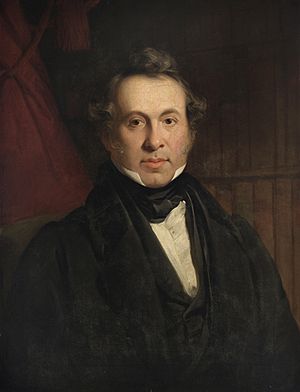James Copland (physician) facts for kids
James Copland (1791–1870) was a Scottish doctor and a very busy medical writer. He wrote many books and articles about health and medicine. He is best known for his huge Dictionary of Practical Medicine, which was like a giant encyclopedia for doctors.
Contents
Early Life and Travels
James Copland was born in November 1791 in Orkney, Scotland. He was the oldest of nine children. He went to school in Lerwick. In 1807, he started studying at the University of Edinburgh. He first studied theology, but later changed to medicine. He earned his medical degree in 1815.
After finishing his studies, Copland moved to London. He couldn't find a job he liked there. So, after about 18 months, he took a job in the Gold Coast (now part of Ghana). He worked as a medical officer for a trading company.
While in Africa, Copland traveled to places like Goree, Senegal, The Gambia, and Sierra Leone. He spent time studying tropical diseases, which are illnesses common in hot, humid climates. On one trip, many sailors on his ship got sick with fever. A big storm also damaged the ship. Copland then traveled along the coast, sometimes walking, sometimes using small boats, until he reached Cape Coast Castle. He lived there for several months.
Medical Career in London
In 1818, James Copland returned to England. He then traveled through France and Germany for a short time. In 1820, he became a licensed doctor with the College of Physicians of London. He settled down in Walworth, a part of London.
By 1822, he moved to Jermyn Street. He also started teaching medicine. He gave lectures at a medical school in Little Dean Street. Later, he taught at the Middlesex Hospital.
Copland became a Fellow of the Royal Society in 1833. This is a very important group for scientists. In 1837, he became a Fellow of the College of Physicians. He became a successful doctor with many patients. He was also elected a member of the American Philosophical Society in 1845.
James Copland was the president of the Pathological Society. He also gave several important lectures, like the Croonian, Lumleian, and Harveian lectures. He stopped working about a year before he passed away. He died in Kilburn, London, on July 12, 1870.
Major Works and Writings
Doctors in Copland's time often wrote books to become more well-known. Copland became famous for collecting and organizing a lot of medical information. He started by writing about the health conditions in West Africa in 1820. He also wrote about various diseases like yellow fever, rabies, and cholera.
In 1822, he became the editor of a medical journal called The London Medical Repository. He wrote many articles for this journal. Other doctors, like John Conolly, helped him with the journal.
The Dictionary of Practical Medicine
In 1825, Copland first planned to create a huge medical encyclopedia. After a few tries, a publisher named Messrs. Longman agreed to the idea. In 1832, the first part of his big work was published.
This massive book was called the Dictionary of Practical Medicine. It ended up being three very large volumes. It had 3,509 pages filled with small print. It was a huge collection of medical knowledge for doctors. Copland later published a shorter version of the Dictionary in 1866.
Views on Medical Topics
Copland was one of the doctors who disagreed with phrenology in the 1820s and 1830s. Phrenology was a popular idea that you could tell a person's personality or intelligence by feeling the bumps on their head. Copland wrote about his doubts regarding this idea.
In 1832, the part of his Dictionary about cholera was published as a separate book. It was called Pestilential Cholera, its Nature, Prevention, and Curative Treatment. Copland believed that cholera could spread from person to person, but not always easily. He debated with another famous doctor, John Snow, about how cholera spread. In 1857, Copland also wrote about the importance of good drainage and sewage systems for health.
Copland continued to write about many medical conditions. In 1850, he wrote a book about paralysis and strokes. In 1861, he wrote about lung diseases like consumption (tuberculosis) and bronchitis. He also covered the causes and prevention of scrofula, a type of tuberculosis that affects the lymph nodes.


